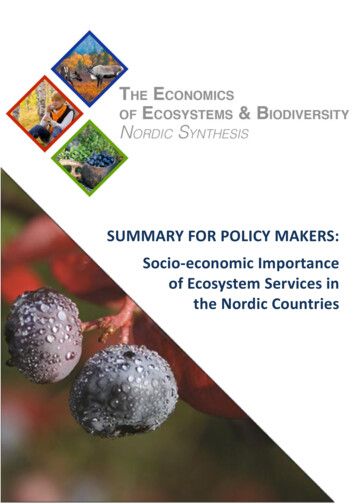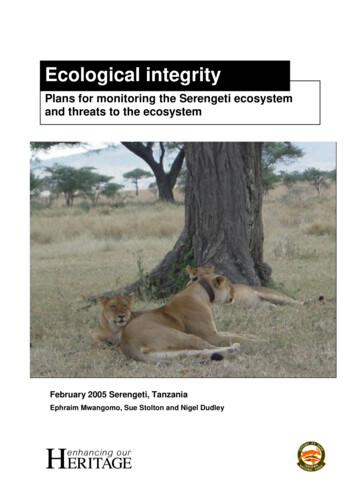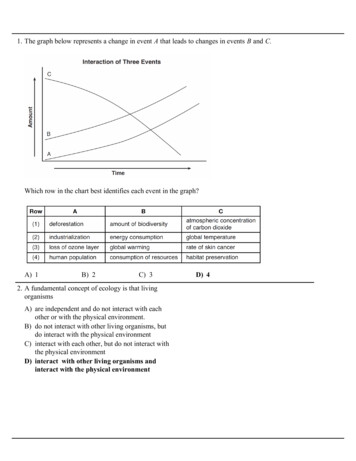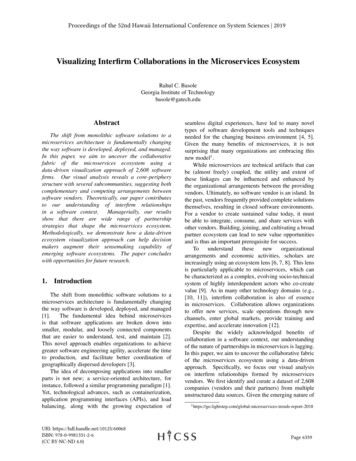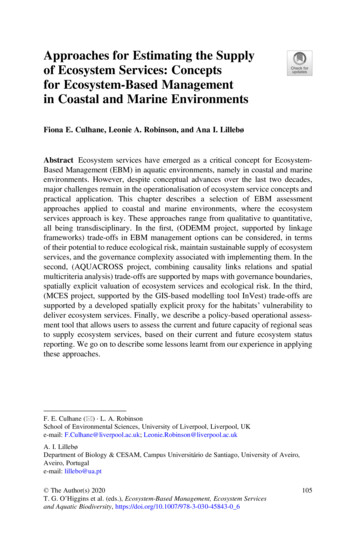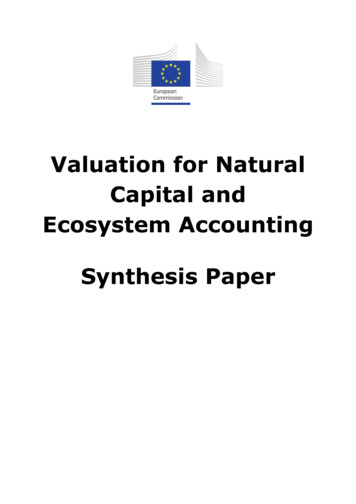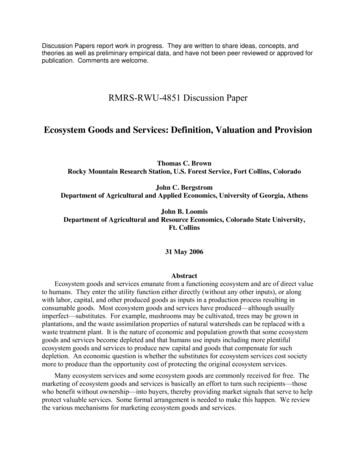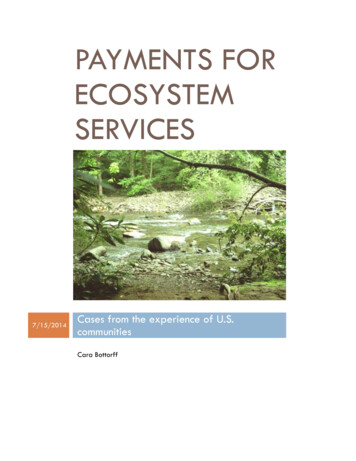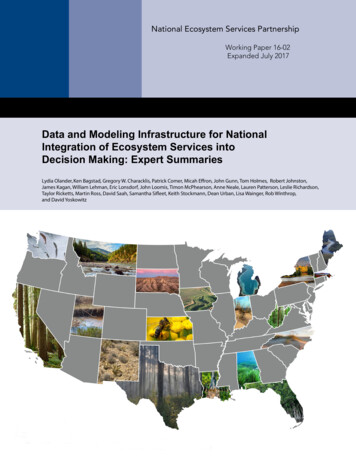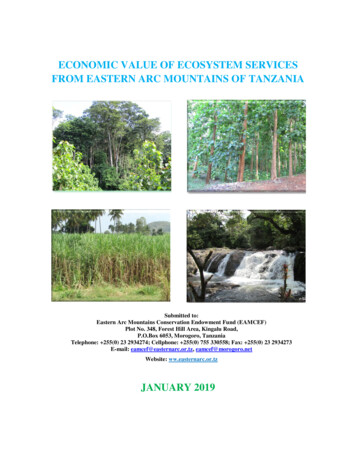
Transcription
ECONOMIC VALUE OF ECOSYSTEM SERVICESFROM EASTERN ARC MOUNTAINS OF TANZANIASubmitted to:Eastern Arc Mountains Conservation Endowment Fund (EAMCEF)Plot No. 348, Forest Hill Area, Kingalu Road,P.O.Box 6053, Morogoro, TanzaniaTelephone: 255(0) 23 2934274; Cellphone: 255(0) 755 330558; Fax: 255(0) 23 2934273E-mail: eamcef@easternarc.or.tz, eamcef@morogoro.netWebsite: ww.easternarc.or.tzWJANUARY2019
ACKNOWLEDGEMENTSThis study was commissioned by the Eastern Arc Mountains Conservation Endowment Fund(EAMCEF) and financed by the Royal Norwegian Embassy in Tanzania through an ongoingconservation project support to EAMCEF. The study team comprised of Dr. Marco A. Njanafrom Nation Carbon Monitoring Centre (NCMC), Sokoine University of Agriculture and Dr.Gody J. Sanga a private researcher on Natural Resource and Environmental Economics.The team was assisted by seven research assistants, Government officials and individuals. Inparticular, the team enjoyed extensive assistance from EAMCEF zonal project coordinators(Magreth Victor and Fredy Mafole of Northern Zone; Rosemary Boniphace and Innocent M.Kilewo of Southern Zone), the Districts officials of Muheza, Korogwe, Lushoto, Same, Mwangaand Kilindi District council and forest department officials of Northern Zone, and Mvomero,Gairo, Kilosa, Kilombero and Ulanga District councils and forest officials of Southern Zone. Theteam is also grateful to the Pangani, Wami/Ruvu and Rufiji Basin Water Office officials. Theirlogistical and moral support helped the team to get all the information needed to accomplish thetask in time.Nevertheless, the team acknowledges the assistance from village executive committees,environmental and water user committees led by village chairmen from all the 28 villagesvisited. The team also acknowledges the assistance provided by Nyumba ya Mungu, Hale, NewPangani, Kidatu, and Kihansi Hydroelectric Power Plants and TANESCO head quarter’sofficials. From TANESCO in particular we appreciate the cooperation provided by Eng.Mansour Hamdun, Eng. Costa Mutagwaba, Eng. Clement Abadyame, Mr. Imani Z. Sakire, Eng.Mathew Bundala, Eng. Mgeni Kisinzah and Mr. Masoud for their moral, logistical andinformation provided to the team that helped in preparing this report.i
LIST OF ACRONYMS & ABBREVIATIONSDOEDivision of EnvironmentCVMContingent Valuation MethodEAMCEFEastern Arc Mountains Conservation Endowment FundEEAEuropean Environment AgencyEIAEnvironmental Impact AssessmentEAMEastern Arc MountainsEMAEnvironmental Management ActESEcosystem ServicesGEFGlobal Environment FundLKHPLower Kihansi Hydropower PlantMAFCMinistry of Agriculture, Food and CooperativesMEAMillennium Ecosystem AssessmentMoWMinistry of WaterMLHRDMinistry of Lands, Housing and Residency DevelopmentMNRTMinistry of Natural Resources and TourismNBSNational Bureau of StatisticsNCMCNational Carbon Monitoring CentreNFNatural ForestNEMCNational Environment Management CouncilNEPNational Environmental PolicyNGONon-Governmental OrganizationKCCMPKihansi Catchment Conservation and Management ProjectKSTKihansi Spray TodKWHKilowatt per HourPESPayment for Ecosystem ServicesPFPlanted ForestPVPresent ValuePBWOPangani Basin Water OfficeWRBWOWami/Ruvu Basin Water Officeii
RBWORufiji Basin Water OfficeSPSSStatistical Package for Social SciencesSTATAStatistical Analysis Software PackageTFSTanzania Forest ServicesTANESCOTanzania Electricity Supply CompanyTAZARATanzania and Zambia Railways CorporationTEVTotal Economic ValueTEEBThe Economics of Ecosystems and BiodiversityTZSTanzania ShillingsTWPFTanzania Wildlife Protection FundUKUnited KingdomUNEP-WCMCUnited Nations Environmental Program-World ConservationMonitoring CentreURTUnited Republic of TanzaniaUSAUnited States of AmericaUSDUnited States DollarWAWorld AtlasWCSTWildlife Conservation Society of TanzaniaWTPWillingness to PayWSDPWater Sector Development Programmeiii
EXECUTIVE SUMMARYIntroductionThis study was carried out to value the Eastern Arc Mountain (EAM) natural assets andecosystem services supplied by the mountains for the purpose of sensitizing the society anddevelopment partners on the ecological and economic importance of the mountains. This isderived from the fact that the EAMs encompasses a series of mountain blocks which are thesources of a number of big rivers draining from the mountain blocks to the Indian Oceansupplying water for domestic and industrial use to many cities and urban centers in easternregions of Tanzania. The mountains are important habitat to the endemic species of plants andanimals. Understanding of the ecological and hydrological importance of the mountains is notenough to justify its conservation but understanding of the economic values of these ecologicaland hydrological importance helps to justify its conservation. In 2015 the Eastern Arc MountainsConservation Endowment Fund (EAMCEF) issued a consultancy work on economic valuation ofEAM ecosystem services and existing assets to a team led by UNEP-WCMC, with inputs fromCambridge, York, Southampton, Exeter Universities in the UK, and Sokoine University ofAgriculture in Tanzania. The work involved field data collection, analysis and drafting acomprehensive report on the value of ecosystem services supplied by the mountains. The studybased its valuation on GIS and hydrological modeling of the EAM natural assets. The report wasprepared and submitted to EAMCEF and EAMCEF provided comments and the consultantsworked on the comments accordingly. However, the approach used tends to undervalue the assetbecause is using the actual market price indices of the ES supplied by the mountains. Followingthis EAMCEF issued the same assignment to another team of consultants to conduct a detailedeconomic value of the mountains this time using market price indices for the ES supplied thatwould help the organization to justify its investment in conserving the mountains againstalternative land uses. This report is a step towards achieving that and was commissioned to twoconsultants by Eastern Arc Mountains Conservation Endowment Fund (EAMCEF) for threemajor objectives: To Identify the Ecosystem Services (ES) in the all EAM blocks, To estimate the economic value of the identified ecosystem services in the EAM blocks, To update the report on EAMs valuation carried out in 2015.iv
Study methodsThe assignment was carried out between 22nd January and 9th February 2018, by conducting fieldsurvey in 28 villages randomly selected from eleven EAMs blocks. To establish the types ofecosystem services the catchment supply and usage at household level, individual householdsurvey which involved interviews of randomly selected household members, village keyinformants, various officials from Rufiji, Pangani and Wami/Ruvu Water Basin Offices, officialsfrom water supply companies (i.e. Tanga UWASA, MOROWASA and DAWASCO), officialsfrom Sugar and rice estates (Mtibwa Sugar, Kilomero Sugar and Kilombero Paddy ProductionLimited), officials from forests and nature reserves (i.e. Udzungwa Mountains National park,Amani Nature Reserve, Magamba Nature Reserve, Chome Nature Reserve, Nilo Nature Reserve,Uluguru Nature Reserve and Mkingu Nature Reserve), officials from forest plantations (i.e.Ukaguru, Mtibwa, Longuza and SAO Hill planted forests), agricultural and forest officers fromMuheza, Mkinga, Korogwe, Lushoto, Same, Mwanga, Morogoro Rural, Mvomero, Kilombero,Kilolo, Mufindi and Mahenge Districts. We also interviewed officials from TANESCO andvisited all the hydropower plants in EAMs (i.e. Nymba ya Mungu, Hale, New Pangani fall,Kidatu, Kihansi, Mbingu Sisters, and Iyovi hydropower plants). We also visited and interviewedTANESCO head office staff in Dar-es-Salaam. The information gathered from these groupsincluded the type of ecosystem used, quantity used and the market prices for those with marketprices.To establish the economic value, we categorized ecosystem services supplied by EAMs intoeight categories: (i) Agricultural ES, (ii) Extracted forest products, (iii) standing timber (iv)water resources (v) Biodiversity, (vi) Carbon sequestration, (vii) Bequest value or value ofexistence and (viii) Tourism. To account for the time preference in our calculation, we have useda discount rate/rate of return to capital of 9 percent as recommended by central bank of Tanzania(BoT) that led to a discount factor of about 0.1214947754. The exchange rate used throughout isUSD 1 Tsh. 2,276.87/ .v
Results and discussionType of ecosystem services supplied by EAMs and their economic valuesThe EAM blocks supply a number of ecosystem services with multiple uses. The ecosystemsservices supplied give the mountains a remarkable economic value as indicated in the Tablebelow.Aggregated total economic value of EAM ecosystem servicesCategories of theEcosystem servicesAgricultural productsExtracted forest productsStanding timberWater resourcesBiodiversityValue of existenceCarbon sequestrationTourismType of the ural forestsPlanted forestsNatural forestsWoodlandPlanted forestsWater (domestic, irrigation,livestock & industrial use)HydropowerBiodiversity valueBequest valueForestsWoodlandTourismEAM total valueEAM NPVTotal value in 28,787,986,000.00% of the 1428.120.00150.000331.070.820.0000093100.00The total economic value of EAM block ecosystem services is 237,069,472,267.08 USD whichis equivalent to 28,685,406,144.32 USD net present value. Standing timber in natural forestsaccount for 37.44% of this value followed by water resource used to generate hydropower(28.12%). Standing timber in woodland take the third place by accounting for 24.84% of the totalvalue followed by standing timber in planted forests which account for 5.69% of the total value.Agricultural crops take the fifth place by accounting for 1.34% followed by fruits productionwhich accounts for 0.39% of the total value. The mountain capacity to store carbon is highaccounting for 1.07% in natural forests followed by woodland which account for 0.82% of thevi
total value. Other ecosystem services account for less than 0.1% of the total value. Higher valuein forest products implies that forest cover dominates the EAMs land area and it shows howimportant forest cover is to the mountain capacity to supply ecosystem services and supportproduction of consumable goods. The capacity to supply ecosystem services and supportproduction of consumable goods varies across the mountain blocks. The Table below clearlyshows that variation among EAMs.Aggregated total economic value of EAM by mountain blocksName of the mountain blockEast UsambaraWest UsambaraSouth PareNorth M total economic valueTotal economic value in .08EAM NPV% of the 4100.0028,787,986,000.00Among the EAM blocks Udzungwa accounts for a higher value followed by far by Uluguru,Rubeho, West Usambara, Ukaguru, Nguru, Nguu, South Pare and East Usambara. The mountainblocks account for 51.54%; 11.08%; 9.24%; 6.50%; 5.10%; 5.08%; 4.36%; 3.14% and 2.96% ofthe total value respectively. Other mountain blocks account for less than 1% of the total value.This also indicate how potential the mountain blocks are in terms of ecosystem servicesprovision, forest stocks, agricultural production supporting services, regulating services andcultural services. Udzungwa mountain block led other mountain blocks in many respects as faras ecosystem services provisioning, supporting, regulating and cultural services are concerned.Uluguru and Rubeho mountain blocks follow in this respect. In addition to the potentiality, thisalso show how well preserved the block is, much of Udzungwa land cover is under reservedvii
areas with a national park in it. This has made the block to have a higher value in standing timberin both forests and woodland, hence higher value in carbon storage and water. This emanatefrom the fact that water has a strong connection with the condition of the forests.Conclusion The EAM blocks have high value in all respect of ecosystem services ranging fromprovisioning, supporting, regulating and cultural aspects. The valuation based on thematerials harvested to consume directly and to produce other consumable goods andservices; Out of the total value, standing timber stocks in natural forests and woodlands, plantedforests and water account for the largest value. The value of these natural assets variesacross the mountain blocks with Udzungwa taking the lead in most of the natural assetsvalued by this study. This not only show how potential the mountain blocks are but alsohow valuable they are that necessitates for more investment in preserving them fortoday’s’ generation and future generations; The study also has revealed that the EAM blocks have higher values of crop, livestockand fruit products. These economic activities employ more than 99.9% of the populationliving in the mountain blocks. However, this depends on the presence of forests andwoodlands which create the climatic conditions favorable for various crop and animalproduction. On the case of extracted timber, the study has revealed a significantly high value oftimber harvested from the mountain blocks natural forests despite the fact that much ofthese forests are under controlled management system. This clearly indicates that there isillegal timber harvesting going on in the mountain blocks. Even though this provideemployment to the people involved along the market chain but it threatens the futurecapacity of the mountains to continue supporting other valuable economic activities asshown by the study; EAMs forests also support the hydropower plants installed in the mountain blocks waterresources. The hydropower generated from the EAMs blocks installed power plantscontribute about one third of the total power generated in the country. Therefore,viii
protecting the EAM blocks forests and its environment is not an option task but a musttask; Apart from direct and consumable economic values, EAM blocks also have highereconomic value in terms of biodiversity, carbon sequestration and bequest value in situvalue of existence. Again these depends on the presence of the forests and itsenvironment; forests provide a habitat for biodiversity to thrive, forests trees and plantsabsorb Co2 from the atmosphere cleaning greenhouse gases and releases O2, and theirexistence is valuable.ix
TABLE OF CONTENTSACKNOWLEDGEMENTS . iLIST OF ACRONYMS & ABBREVIATIONS . iiEXECUTIVE SUMMARY . ivTABLE OF CONTENTS . xLIST OF APPENDICES . xiiiLIST OF TABLES . xivLIST OF FIGURES. xivCHAPTER ONE . 11.0 INTRODUCTION. 1Background of the assignment . 1Objectives of the assignment . 3Nature and scope of the assignment. 3CHAPTER TWO . 42.0 STUDY APPROACH AND LIMITATIONS . 42.1. Ecosystem valuation theoretical background . 42.1.1. The total economic ecosystems services valuation framework. 42.1.2. Study approaches . 52.1.3. Limitation of market based approach in valuing ecosystem services . 62.1.4. Assumptions . 72.2. Methods . 72.2.1. Desk review . 72.2.2. Field survey . 82.3. Data analysis and reporting . 92.3.1. Data analysis . 9CHAPTER THREE . 103.0 THE NATIONAL CONTEXT ON NATURAL RESOURCES MANAGEMENT . 103.1. National issues affecting natural resources management . 103.2. The National forest and water catchment management policy and legal frameworks . 103.2.1. The Constitution of Tanzania (1977-1995). 113.2.2. The national environment policy (1997) and the environmental management Act(2004) 113.2.3. Village Land Act (1999) . 123.2.4. Wildlife Conservation Act (2009) . 133.2.5. The Forest Act (2002) . 143.2.6. The Water Resource Management Act (2009) . 153.2.7. Land Use Planning Act (2007) . 173.3. Summary and relevance of the study . 18CHAPTER FOUR . 204.0 THE EASTERN ARC MOUNTAINS . 204.1. Introduction . 204.2. Geographical Location . 204.3. Physical Characteristics . 214.3.1. Geology. 21x
4.3.2. Climate . 224.3.3. Hydrological characteristics and flow variation . 234.4. Ecological characteristics . 244.4.1. Vertebrates . 254.4.2. Trees . 254.4.3. Invertebrates . 284.5. Economic Characteristics . 294.5.1. Demography . 294.5.2. Economic activities . 30CHAPTER FIVE . 325.0 TYPES OF ECOSYSTEM SERVICES FOUND IN EAMS AND PROPORTION OFHOUSEHOLD BENEFITING. 325.1. An overview of EAMs ecosystem services . 325.2. Types of ecosystem services from EAMs . 325.2.1. Provisioning ecosystem services from EAM blocks forests . 335.2.2. Regulating ecosystem services . 465.2.3. Supporting ecosystem services . 465.2.3.2.Cassava, Sweet potatoes and Irish potatoes . 485.2.3.3.Sunflower, Pigeon pea and Cow pea . 485.2.3.4.Sugarcane, sesame, and yams . 495.2.3.6.Amaranths, White radish and Sweat potato leaves . 525.2.3.9.2.Passions, Watermelon, Guava and Peas . 56CHAPTER SIX . 616.0 ECONOMIC VALUE OF EAMS ECOSYSTEM SERVICES . 616.1. Introduction . 616.2. The economic role of EAMs . 616.2.1. Value of crops produced from EAMs . 626.2.2. Value of fruits produced from the EAMs. 806.2.3. Economic value of vegetables produced in EAMs . 896.2.4. Value of Livestock kept in EAMs . 1046.3. Economic value of EAMs forests . 1126.3.1. Economic value of standing timber . 1126.3.2. Economic value of extracted timber . 1186.3.3. Economic value of other forest products from natural forests and woodlands . 1236.3.4. Economic value of non-timber products from natural forests and woodlands. 1326.4. Economic value of forests products from planted forests . 1376.4.1. Economic value of timber related products from EAM planted forests . 1376.4.2. Economic value of non-timber products harvested from planted forests . 1436.4.3. Economic value of EAM carbon sequestration capacity . 1456.4.4. Economic value of EAMs biodiversity . 1486.4.5. Non-use values . 1506.4.6. Economic value of EAMs water resources . 1526.4.7. Economic value of Hydroelectric power generated from water from EAM . 1596.5. The EAMs total economics value . 1626.5.1. Aggregated total economic value of ES from EAM and standing timber . 162xi
6.6. Aggregated total economic value of EAM ecosystem services . 163CHAPTER SEVEN . 1667.0 CONCLUSION AND WAY FORWARD . 166REFERENCES . 168xii
LIST OF APPENDICESAppendix 1: A list of mountain blocks and villages visited during data collection exercise held . 174Appendix 2: Checklist for village government and environmental committee members . 175Appendix 3: Household survey questionnaire . 186xiii
LIST OF TABLESTable 1:Table 2:Table 3:Table 4:Table 5:Table 6:Table 7:2Location, area (km ) and altitudinal range of forests in EAMs . 22Number of household using firewood and charcoal from EAMs . 33Economic value of crops produced from EAMs . 69Economic value of crops produced from EAMs . 74Economic value of crops produced from EAMs . 78Summary of economic value of crops produced in EAMs . 79Economic value of mangoes, oranges, avocado and pineapples fruits produced fromEAMs . 84Table 8: Economic value of passions, watermelon, guava and peas fruits produced fromEAMs . 87Table 9: Summary of economic value of fruits produced in EAMs . 88Table 10: Economic value of tomato, cabbage, pumpkin leaves and amaranths produced fromthe EAMs . 94Table 11: Economic value of white radish, sweet potato leaves, green pepper and okraproduced from the EAMs . 98Table 12: Economic value of Bitter tomatoes, Onions, Cauliflower, Chinese cabbage andEggplant produced from the EAMs . 102Table 13: Summary of economic value of vegetables produced in EAMs . 103Table 14: Economic value of Local chickens, Ducks, Goats and Sheep kept in EAMs . 107Table 15: Economic value of Cows, Cattle and Pigs kept in EAMs . 110Table 16: Summary of economic values of livestock produced in EAMs . 111Table 17: Economic value of standing timber in natural, woodlands and planted forests foundin Easter Arc Mountains . 116Table 18: Summary of economic value of standing timber in EAMs . 117Table 19: Economic value of extracted timber from natural forests, plantations and woodlot 122Table 20: Economic value of other forest products from natural forests and woodlands . 127Table 21: Economic value of other forest products from natural forests and woodlands . 130Table 22: Economic value of other forest products from natural forests and woodlands . 132Table 23: Economic value of non-timber products from natural forests and woodlands . 136Table 24: Economic value of other forest products from planted forests . 141Table 25: Economic value of other timber related forest products from planted forests . 143Table 26: Economic value of non-timber products harvested from planted forest. 145Table 27: Economic value of carbon stocks in EAMs . 147Table 28: Economic value of EAMs biodiversity. 149Table 29: Bequest value of EAMs .
FROM EASTERN ARC MOUNTAINS OF TANZANIA JANUARY 2019 Submitted to: Eastern Arc Mountains Conservation Endowment Fund (EAMCEF) Plot No. 348, Forest Hill Area, Kingalu Road, P.O.Box 6053, Morogoro, Tanzania Telephone: 255(0) 23 2934274; Cellphone: 255(0) 755 330558; Fax: 255(0) 23 2934273 E-mail: eamcef@easternarc.or.tz, eamcef@morogoro.net
